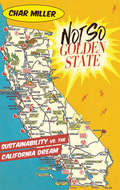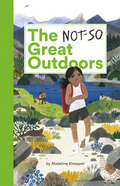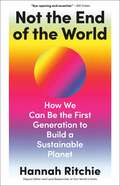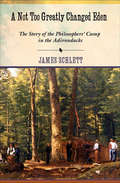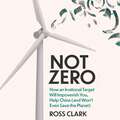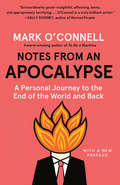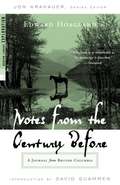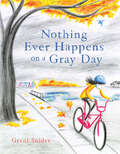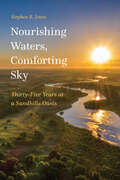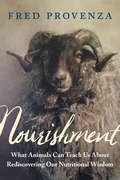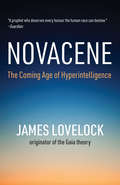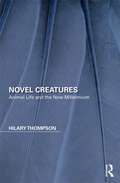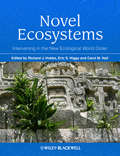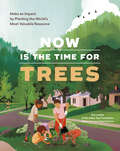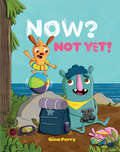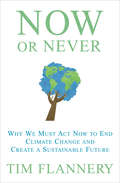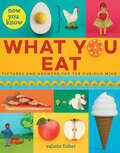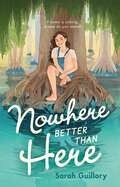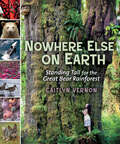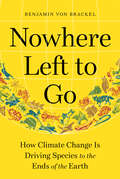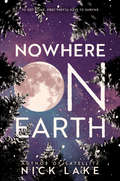- Table View
- List View
The Not-So-Cuddly Cassowary (Fountas & Pinnell LLI Purple #Level P)
by Carmen MoraisThe cassowary isn't like most birds. This human sized creature doesn't fly, can't sing, and can kill a person with a single swipe of its powerful claws. This unique, endangered animal may sound hard to love, but many of its human neighbors say it is a gentle creature that deserves our help.
Not So Golden State: Sustainability vs. the California Dream
by Char MillerIn Not So Golden State, leading environmental historian Char Miller looks below the surface of California's ecological history to expose some of its less glittering conundrums. In this necessary work, Miller asks tough questions as we stand at the edge of a human-induced natural disaster in the region and beyond. He details policy steps and missteps in public land management and examines the impact of recreation on national forests, parks, and refuges, assessing efforts to restore wild land habitat, riparian ecosystems, and endangered species.Why, during a devastating five-year drought, is the Central Valley's agribusiness still irrigating its fields as if it were business as usual? What's unusual, Miller reveals, is that northern counties rich in groundwater sell it off to make millions while draining their aquifers toward eventual mud. Why, when contemporary debate over oil and gas drilling questions reasonable practices, are extractive industries targeting Chaco Canyon National Historic Park and its ancient sites, which are of inestimable value to Native Americans? How do we begin to understand "local," a concept of hope for modern environmentalism? After all, Miller says, what we define as local determines how we might act in its defense.To inhabit a place requires placed-based analyses, whatever the geographic scope--examinations rooted in a precise, physical reality. To make a conscientious life in a suburb, floodplain, fire zone, or coastline requires a heightened awareness of these landscapes' past so that we can develop an intensified responsibility for their present condition and future prospects. Building a more robust sense of justice is the key to creating resilient, habitable, and equitable communities.Miller turns to Aldo Leopold's insight that "all history consists of successive excursions from a single starting point," a location humans return to "again and again to organize another search for a durable scale of values." This quest, a reflection of our ambition to know ourselves in relation to time and space, to organize our energy and structure our insights, is as inevitable as it is unending.Turning his focus to the tensions along the California coastline, Miller ponders the activities of whale watching and gazing at sea otters, thinking about the implications of the human desire to protect endangered flora and fauna, which makes the shoreline a fraught landscape and a source of endless stories about the past and present.In the Los Angeles region these connections are more obvious, given its geography. The San Gabriel Mountains rise sharply above the valleys below, offering some of the steepest relief on the planet. Three major river systems--the Santa Ana, San Gabriel, and Los Angeles--cut through the range's sheer canyons, carrying an astonishing amount of debris that once crashed into low-lying areas with churning force. Today the rivers are constrained by flood-control dams and channels. Major wildfires, sparked by annual drought, high heat, and fierce Santa Ana winds, move at lightning speed and force thousands to flee.The city's legendary smog, whose origins lie in car culture, was fueled in part by oil brought to the region's surface in the late nineteenth century. It left Angelenos gasping for breath as climatic conditions turned exhaust into a toxic ozone layer trapped by the mountains that back in the day were hard to see. Clearing the befouled skies took decades.Every bit as complex is the enduring effort to regenerate riparian health and restore wildlife habitat in a concrete-hardened landscape. The emerging tensions are similar to those threading through the U.S. Forest Service's management of the Angeles National Forest, exacerbated whenever a black bear ambles into a nearby subdivision.How we build ourselves into these spaces depends on the removal of competing users or uses: a historic strawberry patch gives way to a housing development, a memorial forest goes up in smoke, a small creek tells a larger tale of the human impress, and struggles over water-a perennial issue in this dry l...
The Not-So Great Outdoors
by Madeline KloepperA reluctant camper discovers that the (not-so) great outdoors can be just as exciting as screens and skyscrapers in this playful picture book celebration of the pleasures of unplugging and embracing nature.What's so great about the "great outdoors"? A grumpy urban kid begrudgingly accompanies her family on a summer camping trip, missing all the sublime sights right under her nose as she longs for the lights and stimulation of the city. But as she explores forests, lakes and mountains, and encounters bears, beavers and caribou, she slowly comes to realize that the simpler things are just as sparkly, that the sky is its own majestic light show, and the symphony is all around. The Not-So Great Outdoors is a humorous and richly imagined reminder of the beauty and magic that can be found away from the city and our screens.
Not the End of the World: How We Can Be the First Generation to Build a Sustainable Planet
by Hannah RitchieThis "eye-opening and essential" book (Bill Gates) will transform how you see our biggest environmental problems—and explains how we can solve them. It&’s become common to tell kids that they&’re going to die from climate change. We are constantly bombarded by doomsday headlines that tell us the soil won&’t be able to support crops, fish will vanish from our oceans, and that we should reconsider having children. But in this bold, radically hopeful book, data scientist Hannah Ritchie argues that if we zoom out, a very different picture emerges. In fact, the data shows we&’ve made so much progress on these problems that we could be on track to achieve true sustainability for the first time in human history. Did you know that: Carbon emissions per capita are actually down Deforestation peaked back in the 1980s The air we breathe now is vastly improved from centuries ago And more people died from natural disasters a hundred years ago? Packed with the latest research, practical guidance, and enlightening graphics, this book will make you rethink almost everything you&’ve been told about the environment. Not the End of the World will give you the tools to understand our current crisis and make lifestyle changes that actually have an impact. Hannah cuts through the noise by outlining what works, what doesn&’t, and what we urgently need to focus on so we can leave a sustainable planet for future generations. These problems are big. But they are solvable. We are not doomed. We can build a better future for everyone. Let&’s turn that opportunity into reality.
Not This Bear
by Bernice MyersAn amusing story for preschoolers or young readers with the pictures described. Herman is walking through the woods to visit Aunt Gert when a bear sees his furry hat and coat and thinks he's the bears' cousin Julius. Big Brown bear takes Herman home to his cave. Herman has fun eating supper with the friendly bears but he can't make them believe he's a little boy. Herman doesn't want to hibernate all winter long with them. Children will have fun finding out how Herman finally manages to go along his own way.
A Not Too Greatly Changed Eden: The Story of the Philosophers’ Camp in the Adirondacks
by James SchlettIn August 1858, William James Stillman, a painter and founding editor of the acclaimed but short-lived art journal The Crayon, organized a camping expedition for some of America's preeminent intellectuals to Follensby Pond in the Adirondacks. Dubbed the "Philosophers' Camp," the trip included the Swiss American scientist and Harvard College professor Jean Louis Rodolphe Agassiz, the Republican lawyer and future U.S. attorney general Ebenezer Rockwood Hoar, the Cambridge poet James Russell Lowell, and the transcendental philosopher Ralph Waldo Emerson, who would later pen a poem about the experience. News that these cultured men were living like "Sacs and Sioux" in the wilderness appeared in newspapers across the nation and helped fuel a widespread interest in exploring the Adirondacks. In this book, James Schlett recounts the story of the Philosophers' Camp, from the lives and careers of--and friendships and frictions among--the participants to the extensive preparations for the expedition and the several-day encampment to its lasting legacy. Schlett's account is a sweeping tale that provides vistas of the dramatically changing landscapes of the United States in the second half of the nineteenth century. As he relates, the scholars later formed an Adirondack Club that set out to establish a permanent encampment at nearby Ampersand Pond. Their plans, however, were dashed amid the outbreak of the Civil War and the advancement of civilization into a wilderness that Stillman described as "a not too greatly changed Eden." But the Adirondacks were indeed changing. When Stillman returned to the site of the Philosophers' Camp in 1884, he found the woods around Follensby had been disfigured by tourists. Development, industrialization, and commercialization had transformed the Adirondack wilderness as they would nearly every other aspect of the American landscape. Such devastation would later inspire conservationists to establish Adirondack Park in 1892. At the close of the book, Schlett looks at the preservation of Follensby Pond, now protected by the Nature Conservancy, and the camp site's potential integration into the Adirondack Forest Preserve.
Not Zero: How an Irrational Target Will Impoverish You, Help China (and Won't Even Save the Planet)
by Ross ClarkThe British government has embarked on an ambitious and legally-binding climate change target: reduce the country's greenhouse gas emissions to Net Zero by 2050. The Net Zero policy was subject to almost no parliamentary or public scrutiny, and is universally approved by our political class. But what will its consequences be?Ross Clark argues that it is a terrible mistake, an impractical hostage to fortune which will have massive downsides. Achieving the target is predicated on the rapid development of technologies that are either non-existent, highly speculative or untested. Clark shows that efforts to achieve the target will inevitably result in a huge hit to living standards, which will clobber the poorest hardest, and gift a massive geopolitical advantage to hostile superpowers such as China and Russia. The unrealistic and rigid timetable it imposes could also result in our committing to technologies which turn out to be ineffective, all while distracting ourselves from the far more important objective of adaptation.This hard-hitting polemic provides a timely critique of a potentially devastating political consensus which could hobble Britain's economy, cost billions and not even be effective.
Notes from an Apocalypse: A Personal Journey to the End of the World and Back
by Mark O'Connell"Harrowing, tender-hearted, and funny as hell" —Jenny Offill&“Fascinating…Oddly uplifting&” —The Economist"Smart, funny, irreverent, and philosophically rich" —Wall Street JournalBy the author of the award-winning To Be a Machine, an absorbing, deeply felt book about our anxious present tense—and coming to grips with the futureWe're alive in a time of worst-case scenarios: The weather has gone uncanny. Old postwar alliances are crumbling. A pandemic draws our global community to a halt. Everywhere you look there's an omen, a joke whose punchline is the end of the world. How is a person supposed to live in the shadow of such a grim future? What does it mean to have children—nothing if not an act of hope—in such unsettled times? What might it be like to live through the worst? And what on Earth is anybody doing about it?Dublin-based writer Mark O'Connell is consumed by these questions—and, as the father of two young children himself, he finds them increasingly urgent. In Notes from an Apocalypse, he crosses the globe in pursuit of answers. He tours survival bunkers in South Dakota. He ventures to New Zealand, a favored retreat of billionaires banking on civilization's collapse. He engages with would-be Mars colonists, preppers, right-wing conspiracists. And he bears witness to those places, like Chernobyl, that the future has already visited—real-life portraits of the end of the world as we know it. In doing so, he comes to a resolution, while offering readers a unique window into our contemporary imagination.Both investigative and deeply personal, Notes from an Apocalypse is an affecting, humorous, and surprisingly hopeful meditation on our present moment. With insight, humanity, and wit, O'Connell leaves you to wonder: What if the end of the world isn't the end of the world?
Notes from the Century Before: A Journal from British Columbia
by Edward Coolbaugh HoaglandShowcasing Hoagland's extraordinary gifts for portraiture --- his cast runs from salty prospector to trader, explorer, missionary, and indigenous guide --- "Notes from the Century Before" is a breathtaking mix of anecdote and unparalleled elegy from one of the finest writers of our time.
Notes of an Alchemist
by Loren C. EiseleyPoems on crystals, birds, the outdoors and all aspects of nature.
Nothing Ever Happens on a Gray Day
by Grant SniderWith fantastic bursts of color and lyricism, Grant Snider explores the extraordinary within the ordinary in this ode to seemingly boring days and the wonders that emerge for anyone open to seeing them. The sky is gloomy and the world feels like it's asleep . . . but perhaps all that's required for adventure is a bit of curiosity and patience. After all, an everyday stroll can become an adventure in the blink of an eye. On a day when even the rain is too bored to fall, ride alongside a girl on her rickety bicycle through the familiar scenes of her neighborhood as she rediscovers the colors—a splash of yellow, a flash of red, a flutter of blue—that can be found even when all seems monochrome. In this artful picture book that celebrates do-nothing days and solitary adventures, readers learn how embracing quiet stillness with openness and curiosity can make space for unexpected encounters, meaningful detours, and some of life's most unforgettable moments. With luminous illustrations that practically glow on the page, Grant Snider takes readers on a visual journey they'll want to return to again and again.TEACHING MINDFULNESS FOR KIDS: Grant Snider's luminous illustrations will captivate even the most restless young readers, while the story subtly teaches the benefits of patience, silent observation, and mindful awareness.CONNECTING WITH NATURE: Both art and story will inspire children to approach nature with reverence and wonder, explore the outdoors, and learn more about their local environment.OVERCOMING BOREDOM: Themes of childhood boredom and loneliness are addressed in a gentle and heartfelt way, encouraging a spirit of exploration, curiosity, and connection with the natural world. RAINY DAY LOVERS: For those who appreciate the coziness and comfort of a rainy day, this book is a must-have. STORYTIME READ-ALOUD: The gentle pace and lilting rhythm make this a soothing read for storytime at home, at school, or in a library.Perfect for:Parents and grandparents of introspective, introverted, or independent daydreamersReaders who enjoy kids adventure stories and books about natureFamilies and classrooms seeking a great read-aloud bookFans of Grant Snider's previous titles, including What Color Is Night?, What Sound Is Morning?, and There Is a Rainbow
Nourishing Waters, Comforting Sky: Thirty-Five Years at a Sandhills Oasis
by Stephen R. JonesIn the Nebraska Sandhills, ranchers on horseback and in pickup trucks share the range with pronghorn antelope, burrowing owls, and long-billed curlews. The native grasses grow greener as the cattle grow fatter. Throughout the region, river otters and mink swim in streams nourished by springs bubbling up from the High Plains (Ogallala) aquifer. Over years of close observation, Stephen R. Jones has gotten to know the Nebraska Sandhills—the twenty-thousand-square-mile expanse of stunning prairie and thriving wetlands. He has felt the warm breath of a white-tailed doe guarding her spotted fawn, learned to communicate with a family of long-eared owls, and developed an improbable hiking relationship with a wild turkey. He has documented a breeding bird population that is growing more diverse and witnessed the long-awaited return of nesting trumpeter swans. These personal stories, accompanied by words of insight from Native American leaders, Sandhills ranchers, and grassland ecologists, help us envision a quiet relationship with the natural world.
Nourishment: What Animals Can Teach Us about Rediscovering Our Nutritional Wisdom
by Fred ProvenzaReflections on feeding body and spirit in a world of change <P><P> Animal scientists have long considered domestic livestock to be too dumb to know how to eat right, but the lifetime research of animal behaviorist Fred Provenza and his colleagues has debunked this myth. Their work shows that when given a choice of natural foods, livestock have an astoundingly refined palate, nibbling through the day on as many as fifty kinds of grasses, forbs, and shrubs to meet their nutritional needs with remarkable precision. <P><P> In Nourishment Provenza presents his thesis of the wisdom body, a wisdom that links flavor-feedback relationships at a cellular level with biochemically rich foods to meet the body’s nutritional and medicinal needs. Provenza explores the fascinating complexity of these relationships as he raises and answers thought-provoking questions about what we can learn from animals about nutritional wisdom. <P><P> What kinds of memories form the basis for how herbivores, and humans, recognize foods? Can a body develop nutritional and medicinal memories in utero and early in life? Do humans still possess the wisdom to select nourishing diets? Or, has that ability been hijacked by nutritional “authorities”? Consumers eager for a “quick fix” have empowered the multibillion-dollar-a-year supplement industry, but is taking supplements and enriching and fortifying foods helping us, or is it hurting us? <P><P> On a broader scale Provenza explores the relationships among facets of complex, poorly understood, ever-changing ecological, social, and economic systems in light of an unpredictable future. To what degree do we lose contact with life-sustaining energies when the foods we eat come from anywhere but where we live? To what degree do we lose the mythological relationship that links us physically and spiritually with Mother Earth who nurtures our lives? <P><P> Provenza’s paradigm-changing exploration of these questions has implications that could vastly improve our health through a simple change in the way we view our relationships with the plants and animals we eat. Our health could be improved by eating biochemically rich foods and by creating cultures that know how to combine foods into meals that nourish and satiate. Provenza contends the voices of “authority” disconnect most people from a personal search to discover the inner wisdom that can nourish body and spirit. That journey means embracing wonder and uncertainty and avoiding illusions of stability and control as we dine on a planet in a universe bent on consuming itself.
Novacene: The Coming Age of Hyperintelligence (The\mit Press Ser.)
by James LovelockThe originator of the Gaia theory offers the vision of a future epoch in which humans and artificial intelligence together will help the Earth survive.James Lovelock, creator of the Gaia hypothesis and the greatest environmental thinker of our time, has produced an astounding new theory about future of life on Earth. He argues that the Anthropocene—the age in which humans acquired planetary-scale technologies—is, after 300 years, coming to an end. A new age—the Novacene—has already begun.In the Novacene, new beings will emerge from existing artificial intelligence systems. They will think 10,000 times faster than we do and they will regard us as we now regard plants. But this will not be the cruel, violent machine takeover of the planet imagined by science fiction. These hyperintelligent beings will be as dependent on the health of the planet as we are. They will need the planetary cooling system of Gaia to defend them from the increasing heat of the sun as much as we do. And Gaia depends on organic life. We will be partners in this project.It is crucial, Lovelock argues, that the intelligence of Earth survives and prospers. He does not think there are intelligent aliens, so we are the only beings capable of understanding the cosmos. Perhaps, he speculates, the Novacene could even be the beginning of a process that will finally lead to intelligence suffusing the entire cosmos. At the age of 100, James Lovelock has produced the most important and compelling work of his life.
Novel Creatures: Animal Life and the New Millennium (Perspectives On The Non-human In Literature And Culture Ser.)
by Hilary ThompsonNovel Creatures takes a close look at the expanding interest in animals in modern fiction and argues that the novels of this time reveal a dramatic shift in conceptions of "creatureliness." Scholars have turned to the term "creaturely" recently to describe shared aspects of human and animal experience, thus moving beyond work that primarily attends to distinctions between the human and the animal. Carrying forward this recent scholarship, Novel Creatures argues that creatureliness has been an intensely millennial preoccupation, but in two contrasting forms—one leading up to the turn of the century, the other after the tragic events of 9/11.
Novel Ecosystems
by Eric S. Higgs Carol Hall Richard J. HobbsLand conversion, climate change and species invasions are contributing to the widespread emergence of novel ecosystems, which demand a shift in how we think about traditional approaches to conservation, restoration and environmental management. They are novel because they exist without historical precedents and are self-sustaining. Traditional approaches emphasizing native species and historical continuity are challenged by novel ecosystems that deliver critical ecosystems services or are simply immune to practical restorative efforts. Some fear that, by raising the issue of novel ecosystems, we are simply paving the way for a more laissez-faire attitude to conservation and restoration. Regardless of the range of views and perceptions about novel ecosystems, their existence is becoming ever more obvious and prevalent in today's rapidly changing world. In this first comprehensive volume to look at the ecological, social, cultural, ethical and policy dimensions of novel ecosystems, the authors argue these altered systems are overdue for careful analysis and that we need to figure out how to intervene in them responsibly. This book brings together researchers from a range of disciplines together with practitioners and policy makers to explore the questions surrounding novel ecosystems. It includes chapters on key concepts and methodologies for deciding when and how to intervene in systems, as well as a rich collection of case studies and perspective pieces. It will be a valuable resource for researchers, managers and policy makers interested in the question of how humanity manages and restores ecosystems in a rapidly changing world.A companion website with additional resources is available at www.wiley.com/go/hobbs/ecosystems
Now Is the Time for Trees: Make an Impact by Planting the Earth's Most Valuable Resource
by Arbor Day Foundation Dan Lambe&“Celebrates the power of trees to oxygenate the planet, purify water and air, lower city temperatures, provide habitat, nurture the soul, and provide essential food sources.&” —Booklist Trees and forests are the number one nature-based solution for reversing the negative effects of a changing climate. If ever there was a time to be planting trees, that time is now. Inspired by a collective sense of urgency, a global movement to plant trees is gaining momentum. To move the needle, we need to act on a massive scale and plant millions of trees today to have a measurable and lasting impact on billions of lives tomorrow. In Now Is the Time for Trees, the experts at the Arbor Day Foundation will inspire you to do your part by showing you everything you need to know to plant trees at home or in your community. From advice on choosing the right size and type of tree to tried-and-true tips for planting success, this book will help you plant a tree today and leave your own legacy of hope. Equal parts inspiration and advocacy, Now Is the Time for Trees is a rousing call for environmental action and a must-have book for nature lovers everywhere.
Now? Not Yet! (Mo and Peanut)
by Gina PerryPeanut and Moe are back, this time on a camping trip. Peanut wants to swim NOW, Moe says NOT YET! A sweet and cheerful book about overcoming differences.Peanut and Moe are back! Peanut says let's swimMoe says time to hikePeanut says let's swim nowMoe says time to eat a snackPeanut says now!Moe says time to put up the tentPeanut says NOW!Moe says NOT YET!Can these two friends come together in time to save their camping trip?
Now or Never: Why We Must Act Now to End Climate Change and Create a Sustainable Future (Quarterly Essay Ser. #No. 31)
by Tim FlanneryIn Now or Never, the internationally acclaimed author of The Weather Makers returns to the subject of climate change with a book that is at once a forceful call to action and a deeply (and often surprisingly) pragmatic roadmap toward sustainability. Utilizing the most up-to-the-minute data available, Tim Flannery offers a guided tour of the environmental challenges we face and their potential solutions in both the big picture and in specific detail. He explores everything from techniques for storing the carbon that dead plants release into the earth to the fragile balancing act between energy demands and food supply in India and China, from carbon-trading schemes in South America to a recent collaboration between a Danish wind-energy company and an automobile manufacturer that may produce a viable electric car and end the reign of big oil. Now or Never is a powerful, thought-provoking, and essential book about the most urgent issue of our time. It burns with Flannery’s characteristic mix of passion, scientific precision, and "offhand interdisciplinary brilliance” (Entertainment Weekly).
Now You Know What You Eat
by Valorie FisherFrom peanut butter and jelly sandwiches to macaroni and cheese, Valorie Fisher explores the science behind our most delicious dishes!Valorie Fisher dives deep into the science of what we eat and where ingredients come from by exploring what happens behind the scenes of favorite, everyday foods like pizza, honey, milk, maple syrup, vegetable soup, and more! With the help of bold, eye-catching yet simple graphics, inquisitive minds will love discovering what makes popcorn pop, why bread rises, and how bees make honeycomb. With this book peppered with facts like how many eggs a hen lays in a year and how many gallons of sap it takes to make one gallon of syrup, readers will be fascinated by all the amazing things they never knew about the food they eat! Now You Know What You Eat also includes a glossary, and a graphic about the food groups, as well as an introduction to vitamins and minerals. With a growing focus on STEM for this early age group, this book encourages readers to ask their own questions about the world around them, and to fall in love with discovering the answers!
Nowhere Better Than Here
by Sarah GuilloryIn a town slowly being destroyed by rising tides, one girl must fight to find a way to keep her community’s spirit from drowning.For thirteen-year-old Jillian Robichaux, three things are sacred: bayou sunsets, her grandmother Nonnie’s stories, and the coastal Louisiana town of Boutin that she calls home.When the worst flood in a century hits, Jillian and the rest of her community band together as they always do—but this time the damage may simply be too great. After the local school is padlocked and the bridges into town condemned, Jillian has no choice but to face the reality that she may be losing the only home she’s ever had.But even when all hope seems lost, Jillian is determined to find a way to keep Boutin and its indomitable spirit alive. With the help of friends new and old, a loveable golden retriever, and Nonnie’s storytelling wisdom, Jillian does just that in this timely and heartfelt story of family, survival, and hope.In her stunning debut middle grade novel, Sarah Guillory has written a lush story about an indomitable girl fighting against the effects of climate change.
Nowhere Else on Earth: Standing Tall for the Great Bear Rainforest
by Caitlyn VernonYou don't have to live in the Great Bear Rainforest to benefit from its existence, but after you read Nowhere Else on Earth you might want to visit this magnificent part of the planet. Environmental activist Caitlyn Vernon guides young readers through a forest of information, sharing her personal stories, her knowledge and her concern for this beautiful place. Full of breathtaking photographs and suggestions for ways to preserve this unique ecosystem, Nowhere Else on Earth is a timely and inspiring reminder that we need to stand up for our wild places before they are gone. Visit http://www.greatbearrainforest.ca to find teacher and student resources, view the online photo gallery, or read a sample chapter from the book. To access the free teacher's guide for Nowhere Else on Earth, click here:http://orcabook.com/nowhereelseonearth/guides/teachersguide.pdf.
Nowhere Left to Go: How Climate Change Is Driving Species To The Ends Of The Earth
by Benjamin von BrackelHarrowing journeys of animals and plants—fleeing skyrocketing temperatures and mega-droughts—reported from the frontlines of the greatest migration of species since the Ice Age As humans accelerate global warming while laying waste to the environment, animals and plants must flee to the margins: on scattered nature reserves, between major highways, or among urban sprawl. And when even these places become too hot and inhospitable, wildlife is left with only one path to survival: an often-formidable journey toward the poles as they race to find a new home in a warming world. Tropical zones lose their inhabitants, beavers settle in Alaska, and gigantic shoals of fish disappear—just to reappear along foreign coastlines. Award-winning environmental journalist Benjamin von Brackel traces these awe-inspiring journeys and celebrates the remarkable resilience of species around the world. But the lengths these plants and animals must go to avoid extinction are as alarming as they are inspirational: Sea animals—like fish—move on average 45 miles a decade to cooler regions, while land animals—like beavers and butterflies—move 11 miles. As even the poles of the Earth heat up, we’re left with a stark and irreversible choice: Halt the climate emergency now, or face a massive die-off of species, who are increasingly left with nowhere else to go.
Nowhere on Earth
by Nick LakeFrom the Printz Award-winning author of Satellite comes a compelling new novel about a girl who must brave the elements to help a lost child with an otherworldly secret.Sixteen-year-old Emily is on the run. Between her parents and the trouble she's recently gotten into at school, she has more than enough reason to get away. But when she finds a little boy named Aidan wandering in the woods, she knows she needs to help him find his way home. But getting home is no easy matter, especially when Emily finds out that Aidan isn't even from Earth. When their plane crashes into the side of a snowy mountain, it's up to Emily to ensure Aidan and their pilot, Bob, make it off the mountain alive. Pursued by government forces who want to capture Aidan, the unlikely team of three trek across the freezing landscape, learning more about each other, and about life, than they ever thought possible."I love Nick Lake's writing. I would read anything he wrote--grocery list, email, etc.--because his writing, always, is so real and brave. He takes on subjects other writers might avoid, and he writes the hell out of them." --New York Times bestselling author Jennifer Niven on Nick Lake
The NRA Step-by-Step Guide to Gun Safety: How to Care For, Use, and Store Your Firearms
by Rick Sapp National Rifle AssociationHaving shaped our nation since its birth, guns are an integral part of American life. As more and more Americans choose to own firearms, it becomes increasingly important to educate them on proper shooting and handling techniques.Drawing on the National Rifle Association’s more than two centuries of shooting experience, as well as the collected knowledge of more than 55,000 certified instructors, The NRA Step-by-Step Guide to Gun Safety offers key-and life-saving-advice on using, caring for, and storing handguns, rifles, and shotguns. Packed with essential information and resources, including details on how propellants burn in cartridges, shooting etiquette on and off the range, and where to find a certified NRA shooting instructor, The NRA Step-by-Step Guide to Gun Safety will help reinforce the importance of safe gun-handling habits. Included is information on: The safest and most effective way to store and transport pistols, rifles, and shotgunsThe anatomy of the many kinds of guns availableThe proper way to reload any firearmThe best way to clean your gunProper use of eye and ear protectionThe correct clothing to wear while huntingWhether you are an experienced shooter or haven’t shot a round in your life, The NRA Step-by-Step Guide to Gun Safety will provide new and enlightening information that will make you, and your family, safer gun owners.Skyhorse Publishing is proud to publish a broad range of books for hunters and firearms enthusiasts. We publish books about shotguns, rifles, handguns, target shooting, gun collecting, self-defense, archery, ammunition, knives, gunsmithing, gun repair, and wilderness survival. We publish books on deer hunting, big game hunting, small game hunting, wing shooting, turkey hunting, deer stands, duck blinds, bowhunting, wing shooting, hunting dogs, and more. While not every title we publish becomes a New York Times bestseller or a national bestseller, we are committed to publishing books on subjects that are sometimes overlooked by other publishers and to authors whose work might not otherwise find a home.

